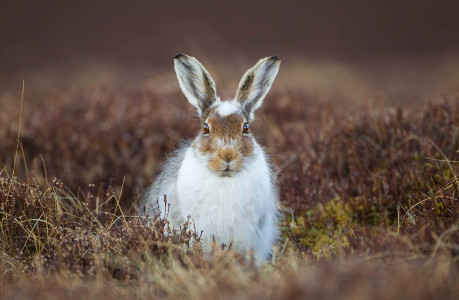Friday 13th October 2017, 9:19am
A coalition of ten environmental and outdoor organisations have repeated their appeal to the Scottish Government to introduce urgent safeguards for mountain hare populations.
The group is asking for a temporary ban on all mountain hare culling on grouse moors until measures are put in place to ensure their numbers can remain at acceptable, sustainable levels.
Involved in the plea are: RSPB Scotland, Scottish Wildlife Trust, Scottish Raptor Study Group, Badenoch and Strathspey Conservation Group, Cairngorms Campaign, National Trust for Scotland, Royal Zoological Society of Scotland, Mammal Society, John Muir Trust and Mountaineering Scotland.
The Scottish Government has a duty to maintain mountain hare populations in a state of good health, otherwise it may be in breach of its legally binding international obligations for this species. However, mountain hares are now routinely culled on a large scale across many grouse moors in Scotland.
This practice has developed relatively recently, in the belief that it protects red grouse against the tick-borne louping ill virus and so increases the surplus of grouse to be shot at the end of the summer. However there is a lack of scientific evidence to support this claim.
In 2014, the coalition warned the Scottish Government that the ‘voluntary restraint’ that was claimed to be in place was unlikely to protect these mammals from wide-scale culls on grouse moors, including in the Cairngorms National Park.
Since then, there have been multiple reports of culls being carried out across the country - suggesting that voluntary restraint has been ignored. These culls are believed to be having a serious negative effect on hare populations. In some areas it has been shown that the culls are leading to severe population declines and potentially even local extinctions.
Duncan Orr-Ewing, from RSPB Scotland, said: “The Scottish Government needs to do more to safeguard these iconic species of our upland areas. In 2014 we had serious concerns that the notion of voluntary restraint would be ignored by many in the grouse shooting industry and, with the evidence of culls continuing on many moors over the last three years, it seems that these fears have been well founded.
“The start of the mountain hare season has already begun, meaning hare populations will continue to be put at risk by unregulated culls. We still do not know what impact these large scale culls are having on mountain hares’ wider conservation status and this could mean that the Scottish Government may be in breach of its legally binding international obligations for this species.
“We trust that this issue will also be considered by the forthcoming independently led expert group, announced by the Cabinet Secretary for the Environment at the end of May 2017, which will be looking at how grouse moors can be managed sustainably and within the law.”
Susan Davies, Director of Conservation, Scottish Wildlife Trust, said: “Mountain hares are an iconic species that act as an indicator of the ecological health of our uplands, and seeing them gives much pleasure to hillwalkers and tourists alike.
“There has been continued and widespread culling throughout the period of voluntary restraint. This suggests that some grouse moor managers have no concern for the long-term viability of mountain hare populations.
“We believe that grouse moor managers have a responsibility for this important native species. Lethal control should be halted until there is both accurate information on the number of hares culled, and the true effect of these culls on the health of the hare population is known.”
Alison Johnstone MSP said: “The unnecessary and unregulated culling of mountain hares on intensive grouse moors across Scotland is damaging populations of this species beyond recovery. I have previously asked the Cabinet Secretary to ban these culls, at the very least in our National Parks, and I support the call from these 10 organisations for the government to do more to safeguard populations of mountain hares and implement a moratorium on culls until work can be carried out to assure those concerned that any necessary mountain hare management can be sustainable.”

Image courtesy of John Muir Trust. Credit: Mark Hamblin/2020Vision.